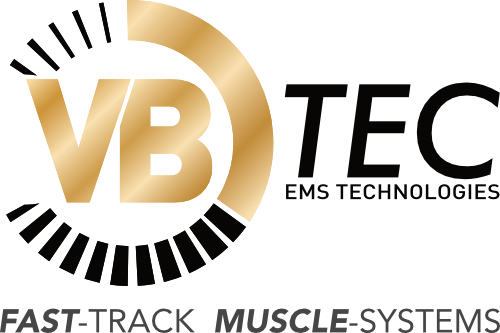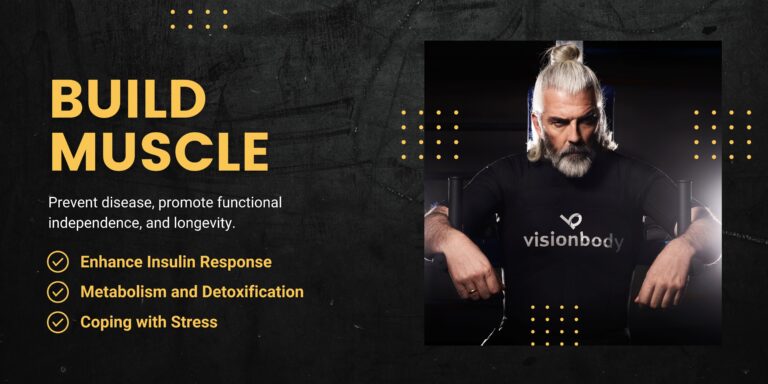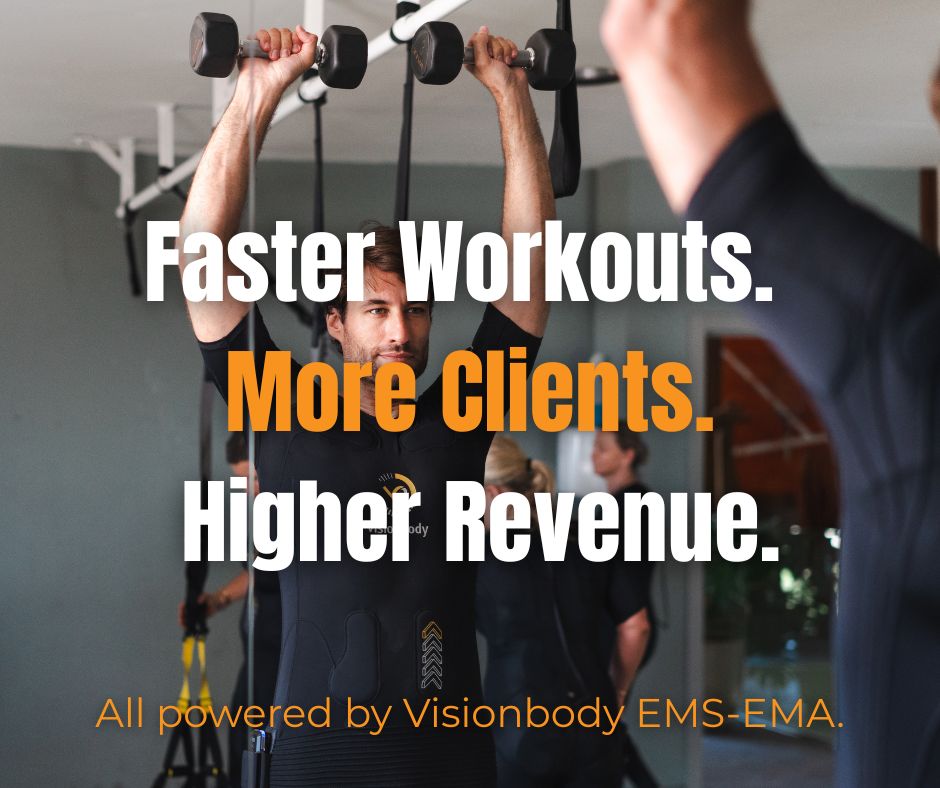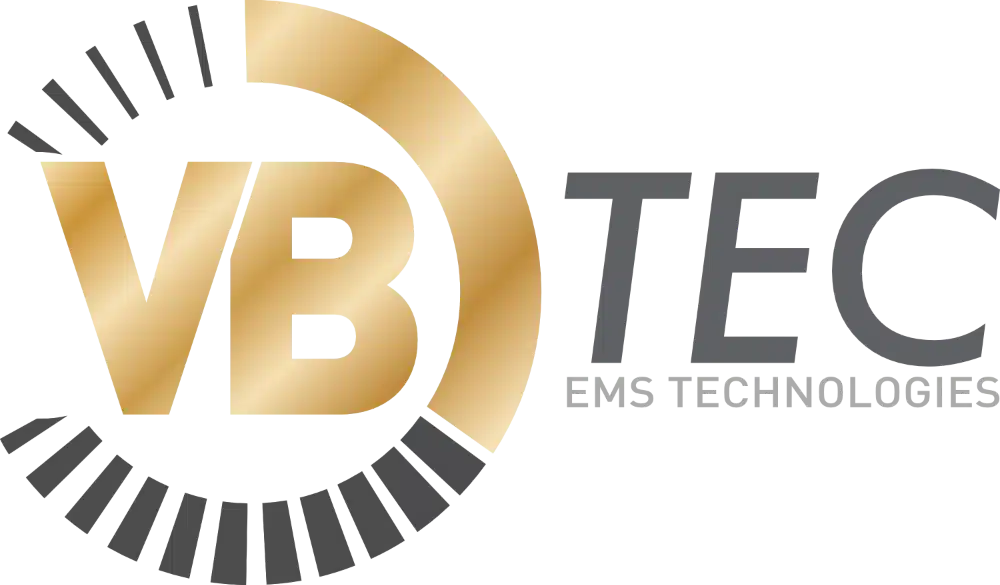I’m Henri Schmidt, sports scientist and founder of Visionbody and VBTec. Over the years dedicated to EMS innovation, I’ve seen firsthand how muscle isn’t just about performance; it’s critical to preventing disease and staying independent as we age.
Most people overlook muscle loss until it affects their health. Through Visionbody EMS, I’ve made it possible to activate and preserve muscle in smarter, more efficient ways, without the wear and tear of traditional training.
In this guide, I’ll walk you through why muscle is your most powerful ally for long-term health, and how EMS can help you protect it.

The Hidden Superpower of Muscle: Disease Prevention and the Role of EMS Training
For years, muscle mass has been viewed mainly through the lens of fitness and aesthetics. But emerging research now confirms that muscle is critical to disease prevention, functional independence, and even longevity.
More than just strength, muscle serves as a metabolic regulator, a cardiovascular protector, and a skeletal support system. Unfortunately, most people lose muscle mass as they age, which can accelerate disease progression and decline. The good news? Modern tools like EMS (Electrical Muscle Stimulation) make it easier than ever to build muscle fast, safely, and effectively, especially when paired with functional movement.
Let’s explore how muscle mass influences health and how Visionbody EMS -EMA is changing the game for prevention, performance, and aging.
Why Building Muscle Is Essential for Lifelong Health
Muscle is one of the most important organs in the body. It communicates with the brain, supports the bones, regulates metabolism, and protects against chronic illness. As we lose muscle, we also lose our body’s ability to:
- Control blood sugar
- Prevent falls and fractures
- Maintain a healthy weight
- Support heart health
Modern lifestyles are increasingly sedentary, which means people start losing muscle earlier and faster. By the time symptoms appear (fatigue, stiffness, weakness), muscle mass is already dangerously low.
The best way to preserve muscle mass is through strength training. However, not everyone has the time, knowledge, or mobility to lift weights. That’s where EMS training becomes a powerful ally. By stimulating deep muscle fibers while you perform gentle movements, EMS enables full-body muscle activation in just 20 minutes, improving strength and metabolic function.
Muscle Mass and Metabolic Disease Prevention
How Muscle Controls Glucose and Insulin Sensitivity
Muscle is the body’s largest glucose disposal system. When a muscle contracts, it pulls sugar out of the blood and stores it as glycogen. The more muscle you have, the more efficient your body becomes at managing blood sugar and insulin.
Low muscle mass reduces glucose uptake, increases insulin resistance, and contributes to:
- Type 2 diabetes
- Obesity
- Metabolic syndrome
Even for people who appear lean, having low muscle mass (a condition known as “TOFI”, thin outside, fat inside) raises metabolic risk.
Combining EMS training with low-impact movement can improve insulin sensitivity and glucose clearance, especially for people with limited exercise capacity. EMS activates Type II muscle fibers (which are metabolically active and tend to atrophy with age), improving metabolic flexibility.
When used regularly, EMS paired with proper nutrition and basic cardio can:
- Enhance insulin response
- Increase lean mass
- Reduce belly fat (visceral fat)
- Stabilize blood sugar
Muscle and Obesity: The Fat-Burning Engine
Muscle burns 3 to 5 times more calories at rest than fat tissue. That makes it essential for maintaining a healthy weight.
Sedentary adults lose muscle over time and gain fat, leading to a slower metabolism, stubborn fat storage, and increased inflammation, all of which drive obesity.
EMS training, especially whole-body protocols like Visionbody EMS, offers high muscle activation with minimal joint stress, which:
- Increases resting metabolic rate
- Triggers fat oxidation
- Supports muscle retention during weight loss
This makes it ideal for busy adults, overweight individuals, or anyone who’s looking to rebuild a healthy body composition quickly and safely.
The Link Between Muscle Mass and Heart Health
Lowering Blood Pressure and Cholesterol Through Muscle Training
The heart isn’t the only muscle that matters. Skeletal muscle supports vascular health and systemic inflammation, two key factors in heart disease.
People with low muscle mass often experience:
- High blood pressure
- Poor circulation
- Elevated cholesterol
- Arterial stiffness
These are precursors to heart attack, stroke, and atherosclerosis.
Strength training has been shown to improve heart health. EMS adds value by:
- Enhancing vascular function via improved circulation
- Activating muscles that support posture and diaphragmatic breathing
- Reducing systemic inflammation, which improves cholesterol and blood pressure markers
Even for those unable to perform traditional cardio, EMS sessions with full-body suits can help support heart health by increasing circulation without overloading the cardiovascular system.
Muscle Mass and Cardiovascular Mortality Risk
Studies confirm that individuals with higher muscle-to-fat ratios experience:
- Lower all-cause mortality
- Better heart function
- Longer lifespan
Age-related muscle loss is linked with increased mortality, particularly from cardiovascular disease. Muscle protects against obesity, inflammation, and blood pressure spikes, all key triggers for heart conditions.
EMS training stimulates muscle without stressing the heart. The Visionbody EMS suit allows users to train safely and comfortably, offering measurable cardiovascular benefits with minimal time commitment.
EMS combined with regular movement can extend healthy lifespan and help reduce cardiovascular risk in people with sedentary or aging lifestyles.
The Role of Muscle in Musculoskeletal Health
Sarcopenia, Aging, and Functional Decline
After age 30, we begin to lose 3-5% of muscle per decade, leading to sarcopenia, a major cause of:
- Falls and fractures
- Poor balance and mobility
- Loss of independence
- Faster biological aging
Sarcopenia affects over 50 million people worldwide and increases risks for injury, hospitalization, and early death.
Resistance training is the most effective intervention, but many older adults can’t safely lift weights. EMS offers a gentle yet effective way to combat sarcopenia by:
- Stimulating deep stabilizing muscles
- Improving posture and gait
- Preventing joint stress
- Supporting neural-motor coordination
Studies show that even 20 minutes of EMS twice per week improves leg strength, balance, and functional independence in seniors.
Bone Health and Muscle Stimulation
Muscles attach to bones, and when muscles contract, they pull on bones, promoting strength and remodeling.
People with low muscle mass are prone to:
- Osteopenia
- Osteoporosis
- Fractures from minor incidents
Muscle weakness also leads to poor posture, joint pain, and spinal instability.
Weight-bearing and resistance exercises promote bone density, but many people with osteoporosis are told to avoid high-impact movement.
This is where EMS shines: it offers bone-supporting muscle activation without risk of injury. An EMS suit is perfect for individuals seeking bone protection without overloading joints, helping them stay active and pain-free.
How EMS Training Supports Muscle Mass and Disease Prevention
What Is EMS and How Does It Work?
EMS (Electrical Muscle Stimulation) is a science-backed training method that uses low-frequency electrical impulses to trigger involuntary muscle contractions, mimicking the natural signals from your brain.

With a system like Visionbody, these impulses are delivered via a comfortable, wireless suit that activates:
- Large muscle groups (glutes, legs, core)
- Small stabilizers (postural and balance muscles)
- Deep Type II fibers essential for power and protection
The result? Full-body muscle training in just 20 minutes, with measurable improvements in strength, endurance, and recovery.
Scientific Benefits of EMS for Health
Electrical Muscle Stimulation has been studied extensively for its broad health applications, not just in fitness, but also in medical, neurological, and rehabilitation settings.
Peer-reviewed research shows that consistent EMS training leads to:
- Increased lean muscle mass and neuromuscular strength, especially in deep and stabilizing muscle fibers
- Enhanced insulin sensitivity and improved blood sugar control, even in people with limited mobility or chronic conditions
- Reduction in chronic inflammation, aiding those with arthritis, post-injury stiffness, or neuromuscular disorders
- Improved proprioception, balance, and joint stability, which are key in fall prevention and long-term joint health
What sets EMS apart is its ability to stimulate muscle contractions beyond voluntary effort, reaching up to 98% of muscle fibers in a single session. This makes it an exceptionally powerful tool for boosting physical function, whether you’re recovering from injury, optimizing athletic performance, or simply investing in long-term health and mobility.
Why Visionbody EMS Is a Smarter Choice for Longevity
Visionbody’s next-gen EMS suit goes beyond standard systems by offering:
- Wireless EMS training: no pads, cords, or gel
- Functional movement integration
- Dry-electrode technology: comfortable, hygienic, and precise
- Controlled settings for each muscle group
Whether you’re training for health, rehab, fat loss, or longevity, Visionbody offers an all-in-one solution, backed by science, trusted by professionals, and built for modern lifestyles.
Frequently Asked Questions (FAQs)
Q: Can EMS replace traditional exercise?
EMS is a powerful tool that complements movement. For people who can’t train traditionally, it’s an ideal alternative. For active users, it enhances and accelerates results.
Q: Is EMS safe for people with heart conditions?
Yes, EMS has been used safely in cardiac rehab programs. Always consult a physician, but EMS can improve circulation, oxygenation, and muscular support for heart health.
Q: How often should I use EMS for health maintenance?
Most users benefit from 2-3 sessions per week, allowing for muscle recovery while seeing consistent progress in strength and tone.
Q: Is EMS helpful for bone and joint health?
Absolutely. EMS supports joints by building surrounding muscle, and stimulates bone remodeling through mechanical tension, without the impact of weights.
Ready to Future-Proof Your Health?
With Visionbody EMS, you can build muscle fast, support heart and metabolic health, and preserve your independence, all in just 20 minutes per session.
👉 Explore Visionbody EMS Now and experience the smarter way to protect your body for life.
References
- Wolfe, R. R. (2006). The underappreciated role of muscle in health and disease. PubMed
- Filipovic, A. et al. (2012). Meta-analysis on EMS training outcomes. PubMed
- Kemmler, W., & von Stengel, S. (2013). Whole-body EMS in older adults. PubMed
- Rantanen, T. et al. (1999). Midlife muscle strength and mortality. PubMed
- Electrical muscle stimulation – An effective tool for strength improvement. PMC6104107









